Modulated Radio Frequency Stealth Waveforms for Ultra-Wideband Radio Fuzes
Abstract
1. Introduction
1.1. Radio Fuzes
1.2. Ultra-Wideband Radio Fuzes
1.3. Chaos Theory
2. Method
2.1. Perturbation Parameter
2.2. Approximate Entropy as a Measure of Complexity
3. Results and Discussion
3.1. Comparison of Complexity
3.2. Comparison of Period Length
3.3. Fuze Performance Analysis
3.3.1. Detection Performance
3.3.2. Anti-Interception Performance
3.3.3. Anti-Jamming Performance
4. Conclusions
Author Contributions
Funding
Institutional Review Board Statement
Data Availability Statement
Conflicts of Interest
References
- Sun, Y.; Gong, S.; Mao, Y.; Dong, Y.Y.; Dong, C.X. Online unsupervised generative learning framework based radar jamming waveform design. IET Radar Sonar Navig. 2023, 17, 1441–1455. [Google Scholar] [CrossRef]
- Gao, J.; Wu, R.; Zhang, J. An adaptive multi-target jamming waveform design based on power minimization. Entropy 2020, 22, 508. [Google Scholar] [CrossRef] [PubMed]
- Yang, Z.; Zhang, B.; Zhang, K.; Shi, J.; Li, Z.; Huang, C.; Zhou, Q. Efficient waveform design with jamming characteristics for precision electronic warfare. Signal Process 2023, 212, 109162. [Google Scholar] [CrossRef]
- Yu, H.; Yan, X.; Hao, X.; Wang, K. Cognition-Based Multi-system Radio Fuze Interference Decision. In Advances in Intelligent Automation and Soft Computing; Springer: Cham, Switzerland, 2022. [Google Scholar] [CrossRef]
- Du, H. Principle of Radio Fuze Anti-Jamming. Weapons Industry; Ordnance Industry Press Co., Ltd.: Beijing, China, 1988. [Google Scholar]
- Lynch, D.D. Introduction to RF Stealth; Scitech Publishing Inc.: Raleigh, NC, USA, 2004. [Google Scholar]
- Chang, W.; Tao, H.; Liu, Y.; Sun, G. Design of synthetic aperture radar low-intercept radio frequency stealth. J. Syst. Eng. Electron. 2020, 31, 64–72. [Google Scholar] [CrossRef]
- Shi, C.; Wang, F.; Zhou, J.; Chen, J. Adaptive radar jamming waveform design based on low probability of intercept. In Proceedings of the China Summit and International Conference on Signal and Information Processing (ChinaSIP), Chengdu, China, 12–15 July 2015; pp. 1017–1021. [Google Scholar]
- Wu, J.; Shi, C.; Zhang, W.; Zhou, J. Power Control Game Between a Distributed Radar Network and a Smart Jammer. IEEE Syst. J. 2023, 18, 61–72. [Google Scholar] [CrossRef]
- Hoseinzade, M.; Andargoli, S.M. Power control and beamforming of phased-MIMO radars to achieve a low probability interception. Digit. Signal Process. 2022, 130, 103645. [Google Scholar] [CrossRef]
- Rad, M.K.; Andargoli, S.M. Power control and beamforming in passive phased array radars for low probability of interception. Digital Signal Processing 2021, 117, 103165. [Google Scholar]
- Dai, X.; Shi, C.; Wang, Z.; Zhou, J. Coalition Game Theoretic Power Allocation Strategy for Multi-Target Detection in Distributed Radar Networks. Remote Sens. 2023, 15, 3804. [Google Scholar] [CrossRef]
- Bekkerman, I.; Tabrikian, J. Target detection and localization using MIMO radars and sonars. IEEE Trans. Signal Process. 2006, 54, 3873–3883. [Google Scholar] [CrossRef]
- Li, J.; Stoica, P.; Zheng, X. Signal synthesis and receiver design for MIMO radar imaging. IEEE Trans. Signal Process. 2008, 56, 3959–3968. [Google Scholar] [CrossRef]
- Li, Y.; Vorobyov, S.A.; Koivunen, V. Ambiguity function of the transmit beamspace-based MIMO radar. IEEE Trans. Signal Process. 2015, 63, 4445–4457. [Google Scholar] [CrossRef]
- Yu, Q.; Bi, D.P.; Chen, L. Jamming technology of research based on pri parameter separation of signal to ELINT system. Fire Control. Command. Control 2016, 41, 143–147. [Google Scholar]
- Dai, S.B.; Lei, W.H.; Cheng, Y.Z. Electronic anti-reconnaissance based on TOA analysis. Electron. Inf. Warf. Technol 2014, 29, 45–48. [Google Scholar]
- Zhang, B.Q.; Wang, W.S. Anti-clustering analysis of anti-reconnaissance based on full pulse information extraction. Electron. Inf. Warf. Technol 2017, 32, 19–25. [Google Scholar]
- Sun, H.; Lu, Y.; Liu, G. Ultra-wideband technology and random signal radar: An ideal combination. IEEE Aerosp. Electron. Syst. Mag. 2003, 18, 3–7. [Google Scholar]
- Jia, J.; Han, Z.; Liang, Y.Y.; Liu, L.; Wang, X. Design of Multi-Parameter Compound Modulated RF Stealth Anti-Sorting Signals Based on Hyperchaotic Interleaving Feedback. Entropy 2022, 24, 1283. [Google Scholar] [CrossRef] [PubMed]
- Jia, J.; Liu, L.; Liang, Y.Y.; Han, Z.; Wang, X. Chaotic Mapping-Based Anti-Sorting Radio Frequency Stealth Signals and Compressed Sensing-Based Echo Signal Processing Technology. Entropy 2022, 24, 1559. [Google Scholar] [CrossRef] [PubMed]
- Dao, X.; Gao, M.; Zhang, Z.; Li, C.; Wang, Y. Design of multi-parameter composite modulated signal for anti-deceptive jamming. AEU Arch. Elektron. Ubertragungstechnik Electron. Commun. 2021, 132, 153646. [Google Scholar] [CrossRef]
- Guo, T.; Zhan, H.; Su, X.; Wang, T. Anti-interrupted sampling repeater jamming method for random pulse repetition interval and intra-pulse frequency agile radar. IET Radar Sonar Navig. 2023, 17, 1796–1811. [Google Scholar] [CrossRef]
- Li, Z.; Li, P.; Hao, X.H.; Yan, X.P.; Wang, J.T. Anti-active noise jamming performance of pulse Doppler fuze. Acta Armamentarii 2015, 36, 1001–1008. [Google Scholar]
- Liu, S.K.; Yan, X.P.; Li, P.; Yu, H. Anti-periodic jamming performance of pulse Doppler fuze. J. Beijing Univ. Aeronaut. Astronaut. 2018, 44, 1018–1025. [Google Scholar]
- Dai, J.; Yan, Q.; Yan, X.P.; Li, P.; Li, Z. Recognition of Jamming and Target Signal for Pulse Doppler Fuze Based on FCM Algorithm with Incremental Update. Acta Armamentarii 2018, 39, 1711. [Google Scholar]
- Dai, J.; Li, Z.; Hao, X.; Li, P. Anti-jamming method for pulse Doppler fuze based on joint feature extraction of target signal. Acta Armamentarii 2019, 40, 225. [Google Scholar]
- Yu, H.; Yan, X.; Jia, R.; Li, Z.; Wang, J. Research on anti-jamming performance of M-sequence pseudo-random code phase modulation pulse doppler fuze. Acta Armamentarii 2020, 41, 417. [Google Scholar]
- Dave, A. DRFMs–Part 4. J. Electron. Def. 2014, 37, 34–36. [Google Scholar]
- Li, J.Y.; Wang J., G.; Yang, J.Y.; Tang, B.; Ye, R.Q. LPI Analysis of UWB Radar. Radar Sci. Technol. 2005, 5, 13–17. [Google Scholar]
- Li, M.; Huang, Z.H. Research on Relation between Sampling Pulse Width and Output Signal Amplitude for Ultra-wideband Radio Fuze. Acta Armamentarii 2016, 37, 1989. [Google Scholar]
- Yan, Y.; Cui, Z.Z. Anti-jamming performance of ultra wideband radio fuze. Acta Armamentarii 2010, 31, 13. [Google Scholar]
- Ma, L.; Wang, T. Performance analysis of UWB-IR anti-intercepting communication based on chaotic mapping. J. China Inst. Commun. 2005, 26, 138. [Google Scholar]
- Tao, S.; Wang, R.; Yan, Y. Perturbance-based algorithm to expand cycle length of chaotic key stream. Electron. Lett. 1998, 34, 873–874. [Google Scholar]
- Pincus, S.M. Approximate entropy as a measure of system complexity. Proc. Natl. Acad. Sci. USA 1991, 88, 2297–2301. [Google Scholar] [CrossRef] [PubMed]
- Woodward, P.M. Probability and Information Theory, with Applications to Radar; Pergamon Press Ltd.: Oxford, UK, 1953. [Google Scholar]
- Dong, E.; Hao, X.; Yan, X.; Yu, H. Research on interference mechanism of swept-frequency jamming to UWB radio fuze. Acta Armamentarii 2023, 44, 1006. [Google Scholar]
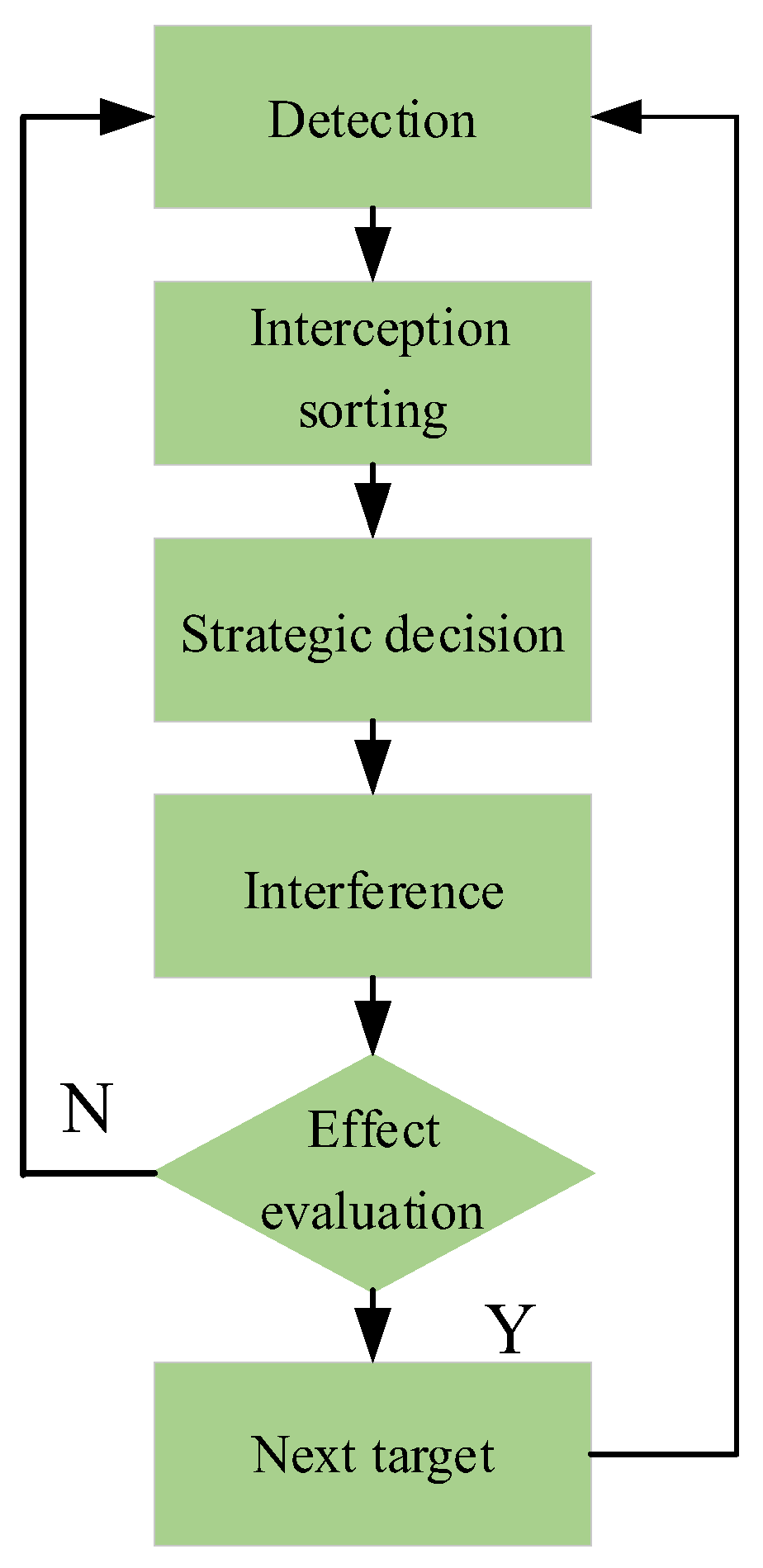
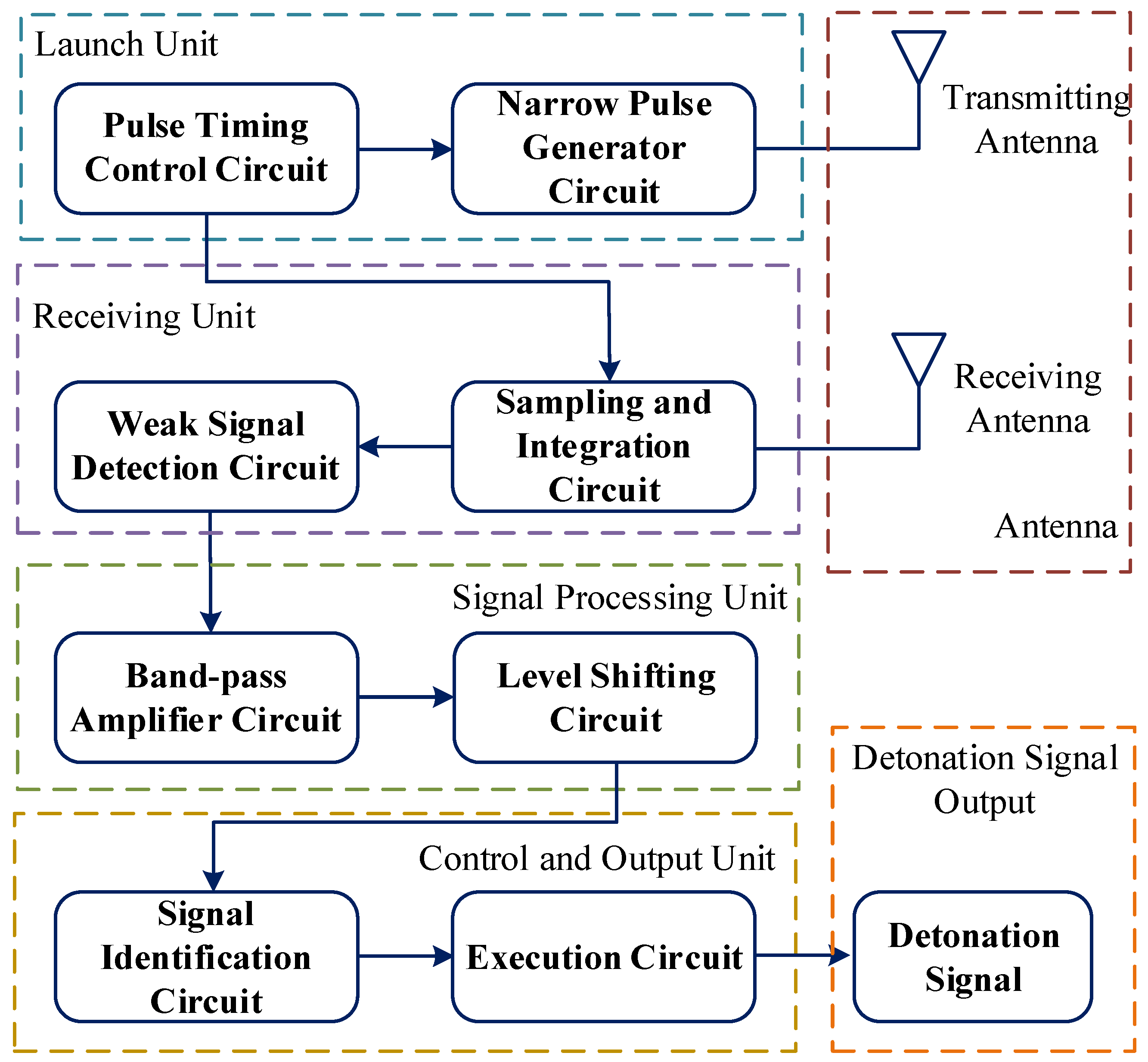


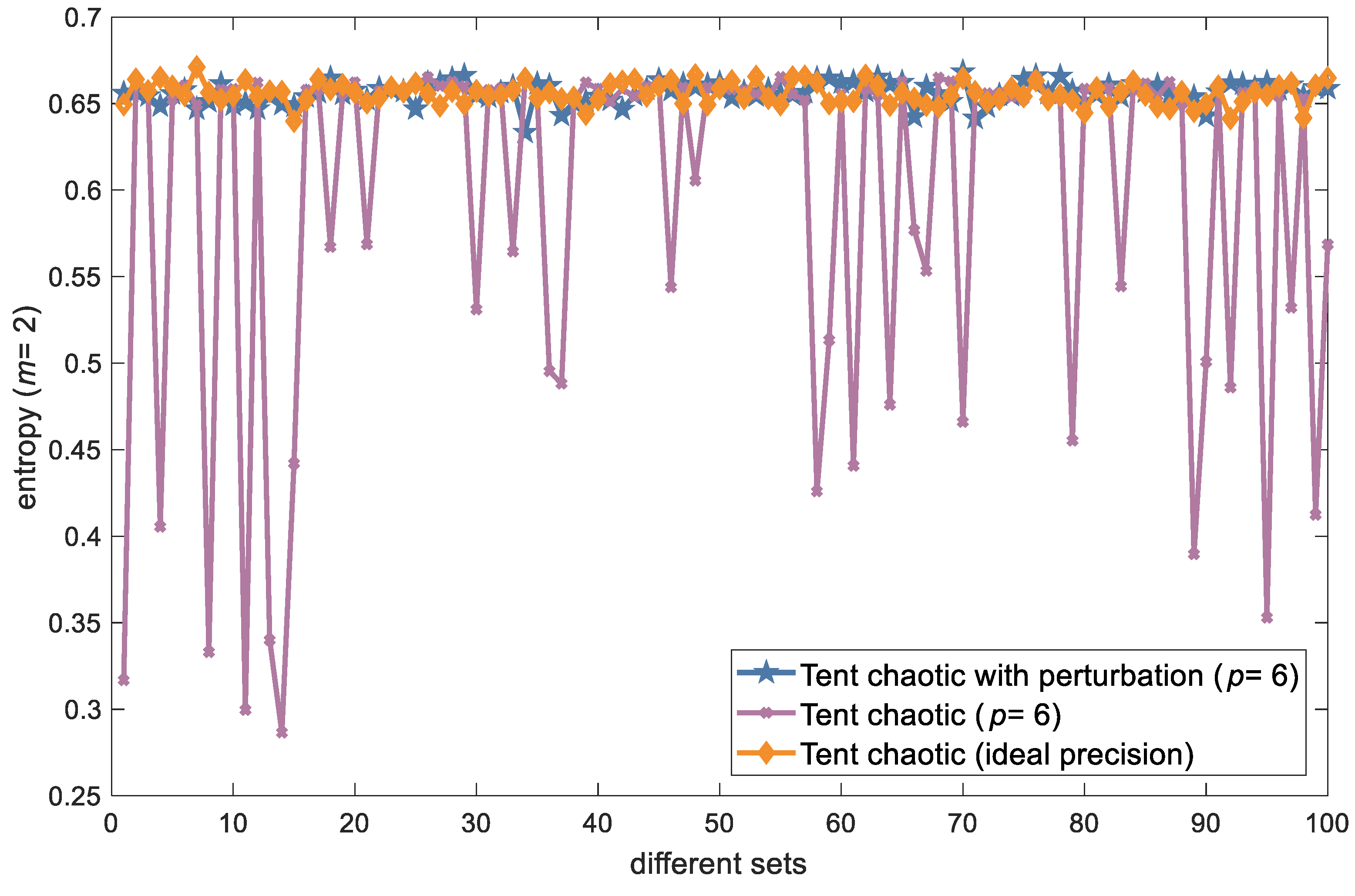


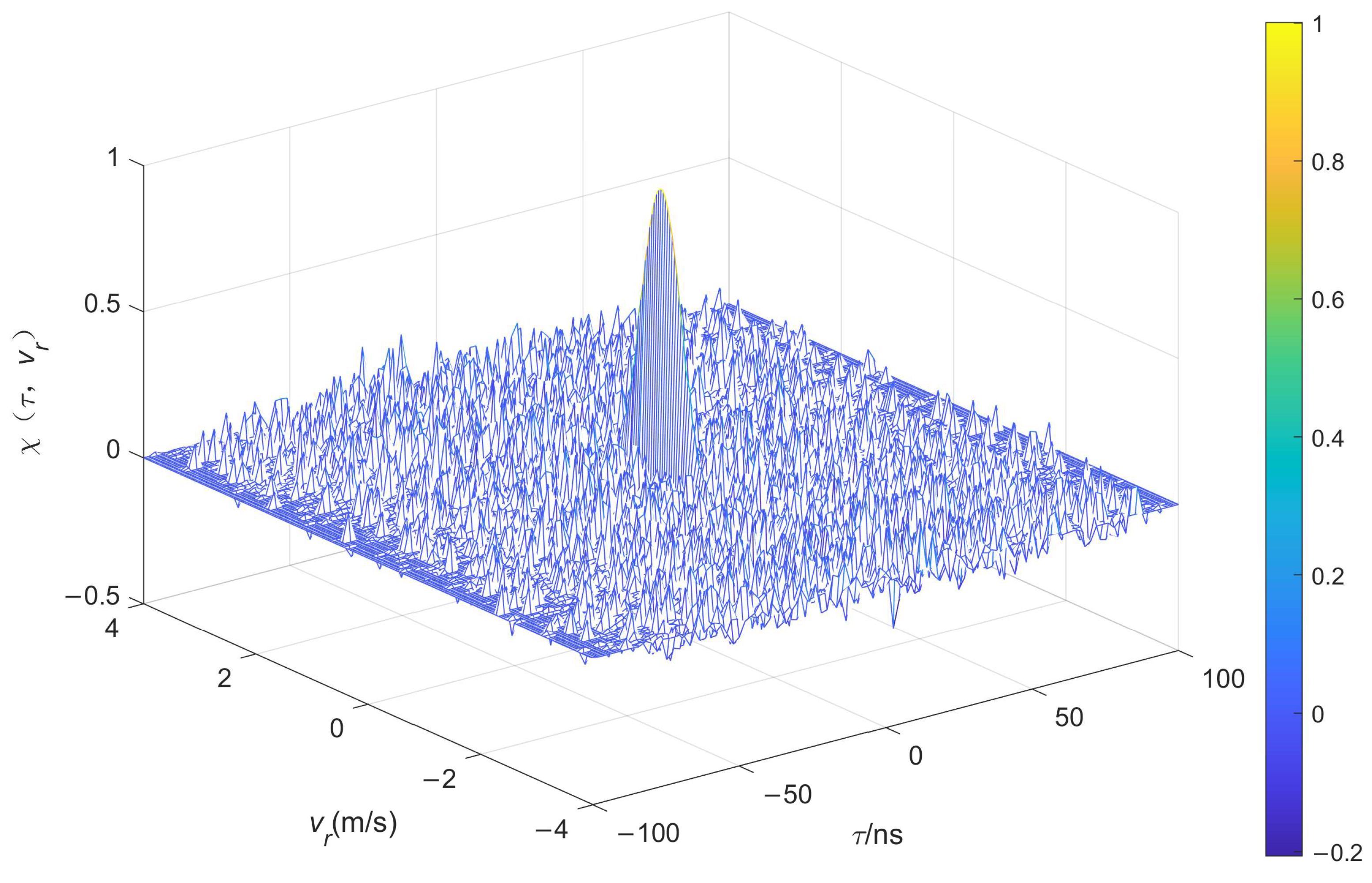

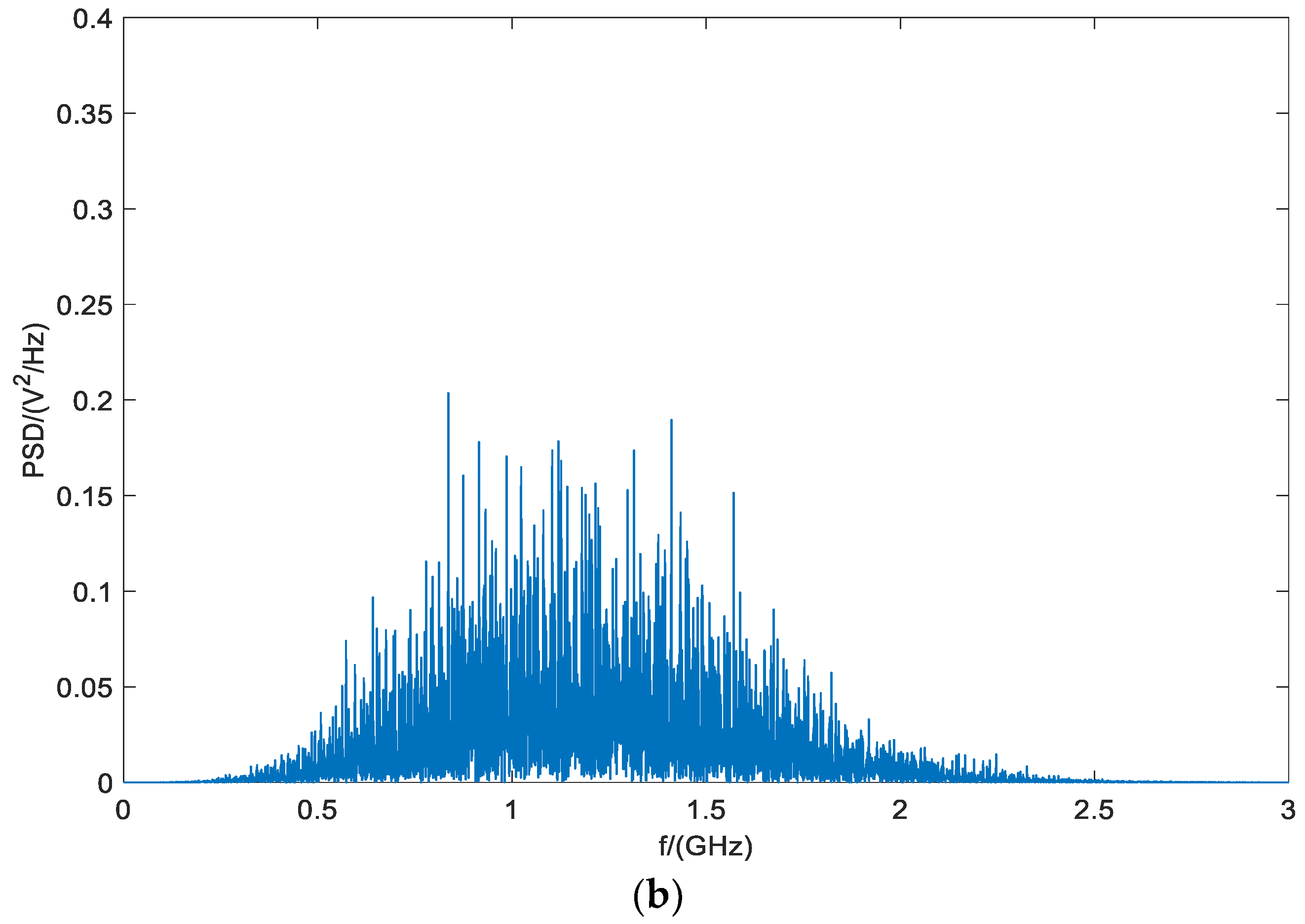


Disclaimer/Publisher’s Note: The statements, opinions and data contained in all publications are solely those of the individual author(s) and contributor(s) and not of MDPI and/or the editor(s). MDPI and/or the editor(s) disclaim responsibility for any injury to people or property resulting from any ideas, methods, instructions or products referred to in the content. |
© 2024 by the authors. Licensee MDPI, Basel, Switzerland. This article is an open access article distributed under the terms and conditions of the Creative Commons Attribution (CC BY) license (https://creativecommons.org/licenses/by/4.0/).
Share and Cite
Wu, K.; Yang, B.; Hao, S.; Liang, Y.; Huang, Z. Modulated Radio Frequency Stealth Waveforms for Ultra-Wideband Radio Fuzes. Entropy 2024, 26, 605. https://doi.org/10.3390/e26070605
Wu K, Yang B, Hao S, Liang Y, Huang Z. Modulated Radio Frequency Stealth Waveforms for Ultra-Wideband Radio Fuzes. Entropy. 2024; 26(7):605. https://doi.org/10.3390/e26070605
Chicago/Turabian StyleWu, Kaiwei, Bing Yang, Shijun Hao, Yanbin Liang, and Zhonghua Huang. 2024. "Modulated Radio Frequency Stealth Waveforms for Ultra-Wideband Radio Fuzes" Entropy 26, no. 7: 605. https://doi.org/10.3390/e26070605
APA StyleWu, K., Yang, B., Hao, S., Liang, Y., & Huang, Z. (2024). Modulated Radio Frequency Stealth Waveforms for Ultra-Wideband Radio Fuzes. Entropy, 26(7), 605. https://doi.org/10.3390/e26070605






